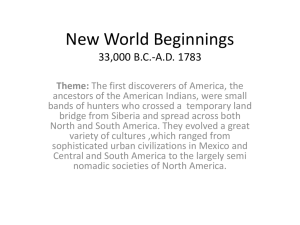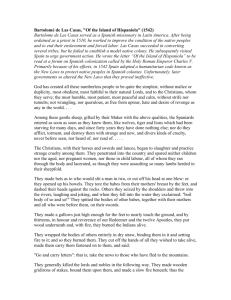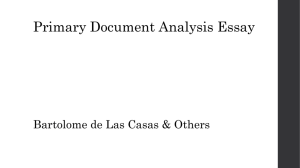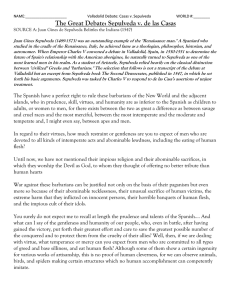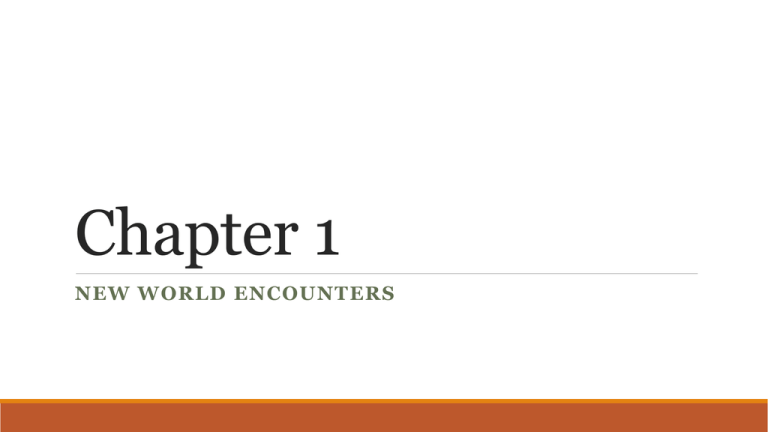
Chapter 1
NEW WORLD ENCOUNTERS
PERIOD 1 (1492 – 1607) INTRODUCTION
http://ap.gilderlehrman.org/period/1
“Clash of Cultures: Interpreting
Murder in Early Maryland”
“Since you [English Settlers] are here strangers, and coming into our
Country, you should rather conform yourselves to the Customs of our
Country, than impose yours upon us.”
What is this quote referencing? What happened in this incident? What does
this tell us about Native and European relationships?
What’s the problem with the historiography offered by Europe during the
age of exploration?
Native American Histories Before Conquest
20,000 years ago—Siberian hunters became first
American inhabitants
14,000 years ago—humans reached tip of South America
These Paleo-Indians did not suffer from many
communicative diseases
The Environmental Challenge: Food, Climate, and Culture
Native Americans enjoyed an abundant
supply of meat
Over-hunted and caused the extinction
of several large species?
Mammoths, mastodons, camels and
even horses!
Climatic warming probably
played a much bigger role
Agricultural Revolution –
shift from hunter-gatherer to basic
crops
Maize, squash and beans
What did agriculture allow
Natives to do? Why is this so
important?
Cahokia
Located in Illinois
Contained approximately
200,00 people!
Natives in the Mississippi
and the Southwest
disappeared, no one
knows why
Aztec Dominance
“When we saw all those (Aztec) towns
Aztecs settled valley of Mexico
and villages built in the water, and other
great towns on dry land, and that straight
level causeway leading to Mexico, we
Center of large, powerful empire
were astounded…Indeed, some of our
soldiers asked whether it was all a
dream”
Highly-organized social and
political structure
- Bernal Diaz de Castillo
Ruled through fear and force
Aztec priest performing the sacrificial
offering of a living human's heart to the
war god Huitzilopochtli
Eastern Woodland Cultures
Atlantic coast of North America
Native Americans lived in smaller bands
Agriculture supplemented by hunting and gathering
Likely were the first natives encountered by English settlers
Locations of Major Indian Groups and Culture Areas in the 1600s
How did the
division
among
natives help
the English
conquer
them?
Cultural Negotiations
“we cannot tell whether everything that
appears faulty to Men, is so in the Eyes of
God”
Diversity of language groups, ethnicities
Place in society defined through kinship
Natives who attended college were:
“absolutely good for nothing being neither Communal, charismatic, sociopolitical formation
acquainted with the true methods of killing
deer, catching Beaver, or surprising an
Diplomacy, trade, war organized around
enemy”
reciprocal relationships
Threats to Survival
TRADE
DISEASE
Native Americans were eager for European trade
Contact brought population decline among
American Indians
They became dependent on, and indebted to,
Europeans
Cause: lack of resistance to epidemic disease
Commerce also influenced warfare patterns
Smallpox
Measles
Influenza
Rate as high as 95%
Columbian Exchange (Page 13)
1. How would you contrast the environmental changes of Columbus’ time to those that
we are experiencing today?
2. Should the historian assign blame for the rapid spread of infectious disease among the
Native Americans after contact with Europeans? Why or why not?
3. Do you think the Columbian Exchange had a more profound effect on the Old or the
New World?
West Africa: Ancient and Complex Societies
Diversity of sub-Saharan cultures
Islam
Strong traditional beliefs
Daily life centered on elder-ruled clans
A history of empires
Mali
Ghana
Portuguese were first to navigate to Africa
(looking for slaves and gold!!)
African soldiers sold POWs to Europe
HOW MANY SLAVES??
17th Century – 1000 Africans per year
18th century – 5.5 million transported to the Americas
By 1860 – 11 million
Before 1831, more African than Europeans came to the
Americas
Europe on the Eve of Conquest
984 AD – Eric the Red founded Greenland
Why is it named “Greenland”?
10th century—Leif Ericson settled “Vinland”
Why did Europe expand in the 15th century?
Rise of nation-states
Spread of new technologies
Spread of old knowledge
1492—Columbus initiated large-scale European colonization
L’Anse aux Meadows
Materials excavated at L’anse Auz Meadows, on the
northernmost tip of Newfoundland, provide
evidence of a Viking settlement in North America.
Using the materials excavated at the site,
archaeologists have reconstructed the typical Norse
dwellings, which had turf walls and roof and
wooden doors and doorframes.
Imagining a New World
Spain becomes the first European nation to achieve conditions for
successful colonization
Unified under Ferdinand and Isabella
1492—Jews and Muslims expelled
Gives rise to conquistadores – Who were these?
Conquest of Canary Islands provided rehearsal for colonization
How?
Christopher Columbus
Columbus persuaded Queen Isabella to finance
westward expedition to “Cathay” (Where is
Cathay)
1492—initial voyage
Where did he land?
Why was he SO lucky?
1506—died clinging to belief he had reached
the Orient
Made possible Spanish dominion in America
Treaty of Tordesillas
What did it say?
Why was it necessary?
How was this land
given the name
“America”?
The Conquistadores
Independent adventurers commissioned by
Spanish crown to subdue new lands
By 1512—major Caribbean islands decimated
By 1521—Cortés destroyed Aztec empire
Montezuma v. Cortes for Tenochtitlan
What happened? How did he defeat the entire Aztec
Empire?
1539–1542—de Soto explored Southeast
1540–1542—Coronado explored Southwest
From Plunder to Settlement
Encomienda System rewarded Conquistadors
Large land grants
Indian inhabitants provided labor or tribute
Appointed officials answered only to crown
Catholic Church
Protected Indian rights
Performed mass conversions
By 1650, half million Spaniards in New World
Unmarried males intermarried
Mixed-blood population emerged
Mulattos, mestizos, criollos
“The first encomenderos, without
known exception, understood
Spanish authority as provision for
unlimited personal opportunism.”
- Charles Gibson
“The New World conquered by you,
has conquered you in turn.”
This tract, a summary of debate concerning the subjugation of Indians, contains the
arguments between Bartolomé de Las Casas, the Bishop of Chiapas, Mexico, and Juan
Gines Sepulveda, an influential Spanish philosopher, concerning the treatment of
American Indians in the New World.
Las Casas came to Hispaniola, in the Caribbean, in 1502 with a land grant, ready to seek
his fortune. A Dominican priest nurtured Las Casas’s interest in the priesthood as well as
his sympathy toward the suffering of the native inhabitants. In 1509, Las Casas
renounced his land grant, released his slaves, and returned to Rome to take his religious
vows. He returned to Hispaniola in 1512 as the first ordained priest in the Americas and
denounced the Spanish exploitation of the Indians and the military conquest of the New
World.
His efforts to end the encomienda system of land ownership and forced labor culminated
in 1550, when Charles V convened the Council of Valladolid in Spain to consider whether
Spanish colonists had the right to enslave Indians and take their lands.
Sepulveda argued against Las Casas on behalf of the colonists’ property rights. Sepulveda
rationalized Spanish treatment of American Indians by arguing that Indians were
“natural slaves” and that Spanish presence in the New World would benefit them.
Citing the Bible and canon law, Las Casas responded, “All the World is Human!” He
contradicted Sepulveda’s assertions that the Indians were barbarous, that they
committed crimes against natural law, that they oppressed and killed innocent people,
and that wars should be waged against infidels. Las Casas managed to convinced the
theologians at Valladolid that the Spanish policy was unjust and had to change. However,
his victory had no impact on the colonists, who continued to enslave American Indians.
Las Casas has been called the “father of anti-imperialism and anti-racism,” and he greatly
influenced the drive to abolish the Spanish encomienda system.
The French Claim Canada
1608—Samuel de Champlain founded Québec
The French wanted to find wealth AND convert Natives.
How does this dictate how the French were to
treat the Natives?
French empire eventually included
St. Lawrence River, Great Lakes, Mississippi
French crown makes little effort to foster settlement
Fur trade underpinned economy
Indians became valued trading partners
The English Enter the Competition
Protestant Reformation played a major role in England’s rise
to dominance
Why? How?
1517—Martin Luther sparked reform in Germany
1536—John Calvin’s Institutes published in Geneva
Reformation pitted European Protestants against Catholics
Reformation under Henry Vlll (1509–1547) strengthened Crown
Death of Mary I (1553–1558) cut short English Catholic CounterReformation
Elizabeth I (1558–1603) consolidated English Reformation
GREAT ruler, ended religious turmoil in England
Militant Protestantism
Lutheran Reformation
God speaks through Bible, not through Pope
or priests
Justification by faith alone for salvation
Calvinist Reformation
Predestination—some persons chosen by
God for salvation
Calvinist Christianity expanded in
northern Europe
Religion, War, and Nationalism
Spanish hostility made Elizabeth the
symbol of English, Protestant nationhood
Sea Dogs’ seizure of Spanish treasure
made them English heroes
Elizabeth’s subjects raided Spain’s
American empire
1588—Spanish Armada
defeated
Irish Rehearsal for American Settlement
English experiences in Ireland shaped how they would conquer the New World
To the English, the Irish were wild and barbaric
They would view Native Americans the same way
Mystery at Roanoke
Sir Walter Raleigh established Roanoke
colony in 1584
He named the region Virginia after the
Virgin Queen
The colony failed and Raleigh tried again
in 1587
The colonists disappeared without a trace
and their fate remains a mystery
Campaign to Sell America
By 1600, no English settlements in New World
Richard Hakluyt advertised benefits of American colonization
The Principal Navigations, Voyages, and Discoveries of the English Nation
Claimed that England NEEDS American colonies
What are the problems with his book?!
Africans?
Natives?
Chapter 2
ENGLAND’S SEVENTEENTH
CENTURY COLONIES
JAMESTOWN
Joint Stock Company – business
venture where multiple people could invest
without risk of bankruptcy
London (Virginia) Company established
Jamestown (with 104 men!)
PROBLEMS:
Salty water
Swamp
Malaria
Searched for gold
Didn’t want to work
John Smith
John Smith
◦ Took control of the ruling council in Fall
1608
◦ “Work or get out”
◦ Help of the Powhatan
◦ Turned colony around!
◦ Accident...or was it?
Starving Time – Winter of 1609-1610….Cannibalism?
http://krwg.org/post/bones-tell-tale-desperationamong-starving-jamestown
The “Stinking Weed”
1612 – John Rolfe begins to export tobacco
Profits increase significantly in Jamestown
In order to make Jamestown more desirable, they established a House of Burgesses
◦ First representative government in the colonies!
Headright system – colonists who provided their own transportation received 50 acres of
land!
◦ Gave rise to indentured servants
◦ What social effect did this have on the colonies?
Maryland
Founded in 1634 by Lord Baltimore (Cecilius Calvert). James I
granted charter for friend.
Act of Toleration – 1649 – Religious Freedom for some, Catholics
pushed out soon after.
◦ Why was MD opened to Protestants?
Protestant majority, reliant on tobacco
Consistently had trouble governing the area, constant in-fighting
over religion
Maryland Toleration Act of 1649; September 21, 1649
That whatsoever person or persons within this Province and
the Islands thereunto helonging shall from henceforth
blaspheme God, that is Curse him, or deny our Saviour Jesus
Christ to bee the sonne of God, or shall deny the holy Trinity
the father sonne and holy Ghost, or the Godhead of any of the
said Three persons of the Trinity or the Unity of the Godhead,
or shall use or utter any reproachfull Speeches, words or
language concerning the said Holy Trinity, or any of the said
three persons thereof, shalbe punished with death and
confiscation or forfeiture of all his or her lands and goods to
the Lord Proprietary and his heires.
http://www.yale.edu/lawweb/avalon/amerdoc/maryland_tol
eration.htm
Baltimore in 1752, from a sketch by John Moale, Esq.
Baltimore in 1752, from a sketch by John Moale, Esq.
Baltimore was founded in 1629 and served as a shipping center for Maryland tobacco growers. By 1752, when this view
was drawn, it had begun to show signs of developing into a prosperous port city. After the American Revolution,
Baltimore expanded and by the 1790s boasted a population of over twenty thousand.
Copyright © Houghton Mifflin Company. All rights reserved.
Reforming England in America
PILGRIMS:
Too much Catholicism in the Anglican Church!
Moved to Holland
What were the probems?
Headed to America in 1620 on The Mayflower
Planned on landing on VA, but went off track!
Established the Plymouth Colony
Landed in Plymouth, wrote the Mayflower Compact
“A covenant to combine ourselves together in a civil body
politick”
PLYMOUTH TROUBLES
Over half died the first year; Bradford
helped them continue
SQUANTO
Who was he? How did he know English?
What impact did he have?
“First Thanksgiving”
Never very financially successful
THE GREAT MIGRATION
1630
Puritans in England searched for meaningful
change to the Anglican Church
Unfairly characterized
More combative than Pilgrims, wanted to purify
the Church from within!
John Winthrop was a humble farmer who
would lead them to Mass. Bay Colony
GREAT MIGRATION
“A CITY ON A HILL”
Mostly farmers and textile workers
MISCONCEPTIONS:
Higher life expectancy
Bound together by a common sense of
purpose
Adopted congregationalism
Each church was independent of outside
influences
Blacks AND women were part of
congregations
By the 1630s, 40% of white males could
vote!
1. Neither a democracy or a theocracy
2. Ministers possessed no formal political
authority
Excerpt: “A Model of Christian Charity”
By Governor John Winthrop, 1630
◦ “We must be knit together in this work;…we must uphold each other…in all meekness,
gentleness, patience and generosity. We must delight each other, make others’
conditions our own, rejoice together, mourn together, labor and suffer
together…
So shall we keep the unit of the spirit, in the bond of peace…ten of us will be able to
resist a thousand of our enemies. For we must consider that we shall be as a City upon a
Hill, the eyes of all people are on us.”
Explain the impact of the Puritan philosophy and
attitude on later events in American history.
KEY CONCEPT: Puritans Went to the New World to preserve their own
religious freedom
Anne Hutchinson, exiled in 1638.
In 1643 she and her family were killed in a war fought between the Dutch colonists
and N. Americans
Began American tradition of Freedom of Consciousness
What does this mean?
Roger Williams, fled MBC in 1636.
Founded Rhode Island – community based on religious tolerance.
Important Why? Shows what?
p://www.rogerwilliams.org/biography.htm http://www.greatwomen.org/women.php?action=viewone&id=84
Dissent in the Puritan Community
Mobility and Division
New Hampshire—1677
Made a separate colony from Massachusetts Bay
Connecticut—1636
First settlements led by Thomas Hooker
1662, king granted a charter
New Haven—absorbed into Connecticut
Rhode Island—1636
Under Roger Williams, it accepted dissenters from Massachusetts
Toleration, but much infighting
1663, king granted a charter
New England Colonies
New Netherlands
1609: Henry Hudson
explores the Hudson River
1621: Dutch establish colony
of New Netherland;
New Amsterdam becomes
capital of the colony
Diverse and profitable bc of
trade
“unstable pluralism”
New Netherlands/York
Duke of York defeats Stuyvesant for Manhattan
in 1664 and 1674
highly stratified society
huge landowners
population soars.
York grants charters to friends Carteret and
Berkeley to create New Jersey.
Diverse but no strong government.
“I cannot but suspect that an assembly would
be of dangerous consequence” – James II
Why?
http://www.colonialvoyage.com/namstmap.jpg
Confusion in New Jersey
Given as a gift to two Civil War courtiers
What type of government?!?!
Only James had the right to decide upon
this…
Eventually sold to the Quakers – not
financially successful
Quakers/Pennsylvania
“Those who tremble at the word of the Lord”
These were members of the Society of Friends
Everyone could be saved!!
1681: William Penn is given land in the Americas as repayment of a debt
Escaped religious persecution
1682: Penn buys more land to establish Delaware & New Jersey
Quakers:
Pacifists
Treated natives as equals, prohibits slavery
Tolerated others faiths and nationalities
Excellent with Agriculture & Trade
Settling Pennsylvania
The people of Pennsylvania “are a collection of diverse nations in Europe,
as French, Dutch, Germans, Swedes, Danes, Finns, Scotch, Irish and
English” – William Penn
Welcomed anyone, not just Quakers!
EXTREMELY diverse religiously
Set up a unicameral representative government
Eventually the “three lower counties” split off and became Delaware
Carolinas
Began by John Colleton, English planter from Barbados
Difficult to recruit Englishmen; finally settled in Charles Town in
1670
Fundamental Constitutions of Carolina, instituted for a balance
between monarchy and democracy
Prior to 1680, much of the Carolina population came from
Barbados – why?
Economy based on Indian Slave Trade and rice plantations
1729 – split into North and South Carolina
Georgia
How could its founding be seen as an
“act of aggression against Spain”?
Founded by James Oglethorpe, 1733
Philanthropist, pauper’s colony
What is a pauper’s colony?
Buffer state with Spanish FL, military setup
in cities and land ownership.
Eventually they allowed slaves, women and
rum


